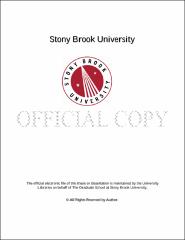| dc.identifier.uri | http://hdl.handle.net/11401/76330 | |
| dc.description.sponsorship | This work is sponsored by the Stony Brook University Graduate School in compliance with the requirements for completion of degree. | en_US |
| dc.format | Monograph | |
| dc.format.medium | Electronic Resource | en_US |
| dc.language.iso | en_US | |
| dc.publisher | The Graduate School, Stony Brook University: Stony Brook, NY. | |
| dc.type | Dissertation | |
| dcterms.abstract | Water-soluble conjugated polymers have emerged as cost-effective, light harvesting materials for the development of highly sensitive and selective biosensing platforms where the detection of a target is recognized through changes in the spectroscopic properties of the conjugated polymer. My thesis describes fundamental studies of interaction in water-soluble conjugated polymers/ DNA organic/biological hybrids and the application of such hybrids in DNA sensing and energy conversion. In particular, I demonstrated a conjugated poly(phenylene vinylene (PPV)/DNA hybrid with sequence dependent photoluminescence and chiroptical properties, for which the PPV photoluminescence was found to be enhanced as high as seven fold upon binding with DNA. These sequence specific spectroscopic and structural changes resulted from hydrophobic interactions in the form of π -π stacking between the PPV backbone and DNA bases. In this study I also demonstrated the importance of electrostatic interactions between PPV's charged side groups and DNA phosphate backbone in promoting hydrophobic interactions leading to sequence specific properties of the hybrid. I then developed a label-free DNA sensor based on Forster Resonant Energy Transfer (FRET) between a water soluble PPV and an intercalating dye, malachite green chloride where the detection of target DNA is read through FRET sensitized fluorescence of the intercalated dye. In the proposed sensor, the PPV bound to DNA experiences photoluminescence enhancement due to a chain conformation change induced by DNA and this enhancement provides improved FRET efficiency and increased FRET sensitized fluorescence from the intercalated dye, the transducing signal for the DNA sensor. Moreover, the particular small dye used by me intercalates hybridized DNA at a maximum, one-to-one dye-to-base pair ratio, which in combination with the FRET sensitization provides a wide range for base pair mismatch detection, from one up to five base pair mismatches for 25 mer single stranded DNA probe and target. Finally, I demonstrated the ability of DNA to promote photoinduced charge transfer between same-charge sign, cationic donor and acceptor moieties, here PPV and fullerene, with efficiencies approaching those observed for oppositely charged donor and acceptor molecules with similar backbones and without DNA. In this same study I also demonstrated the ability to tune the charge transfer rate between same charge type donor and acceptor molecules by replacing single stranded DNA with double stranded (hybridized) DNA and I provided a detailed description of the mechanisms of quenching by charge transfer for the studied donor-acceptor hybrids. | |
| dcterms.available | 2017-09-20T16:50:02Z | |
| dcterms.contributor | Gersappe, Dillip | en_US |
| dcterms.contributor | Cotlet, Mircea | en_US |
| dcterms.contributor | Venkatesh, T | en_US |
| dcterms.contributor | Strey, Helmut. | en_US |
| dcterms.creator | Liu, Zhongwei | |
| dcterms.dateAccepted | 2017-09-20T16:50:02Z | |
| dcterms.dateSubmitted | 2017-09-20T16:50:02Z | |
| dcterms.description | Department of Materials Science and Engineering. | en_US |
| dcterms.extent | 124 pg. | en_US |
| dcterms.format | Monograph | |
| dcterms.format | Application/PDF | en_US |
| dcterms.identifier | http://hdl.handle.net/11401/76330 | |
| dcterms.issued | 2015-08-01 | |
| dcterms.language | en_US | |
| dcterms.provenance | Made available in DSpace on 2017-09-20T16:50:02Z (GMT). No. of bitstreams: 1
Liu_grad.sunysb_0771E_12135.pdf: 9955339 bytes, checksum: e5d1fc507789572769541285a35c1774 (MD5)
Previous issue date: 2014 | en |
| dcterms.publisher | The Graduate School, Stony Brook University: Stony Brook, NY. | |
| dcterms.subject | Materials Science | |
| dcterms.subject | chain conformation, charge transfer, Conjugated polymer, DNA sensor, Eenergy transfer, PPV | |
| dcterms.title | ORGANIC/BIOLOGICAL HYBRID NANOMATERIALS FOR BIOSENSING AND ENERGY CONVERSION: FROM FUNDAMENTALS TO APPLICATIONS | |
| dcterms.type | Dissertation | |

